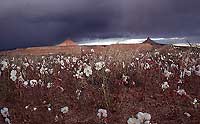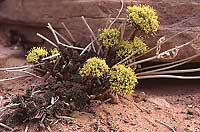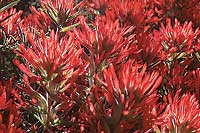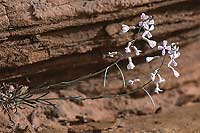While many states are still under a slumber of snow in February, the canyons of Southern Utah are thawing out. The occasional spring storm may still sweep across the landscape dusting it white for several days, but the prospect of spring and forecast for sunny days ahead is strong.
Each year while on winter hikes, I’d spend time scanning the ground searching for the first flowers of February. That honor usually fell to Parry’s lomatium, an easily-overlooked member of the Carrot family whose heads of greenish-yellow flowers barely rose above ground level. The flat-topped cluster of flowers, about the size of a quarter, would bloom before the leaves sprouted, adding to the cryptic nature of this plant.
Named after Charles Christopher Parry (1823-1890), a British-American botanist who was the first official botanist of the U.S. Department of Agriculture, Parry made notable botanical surveys of the American West and discovered numerous species new to science. His travels on the U.S. and Mexican Boundary Survey (1848-1855) as a surgeon and botanist introduced him to the wilds of California, Colorado and Utah, and provided excellent opportunities to collect plants.
So once I see this lomatium in bloom, I know spring and other plants ready to bloom are not far behind.
Twinpod, rockcress, desert spring-parsley, Indian paintbrush, evening primrose and Easter flower are several other wildflowers that bloom in the early spring. Twinpod, a member of the Mustard family, has small yellow flowers arranged in a cross shape, and after pollination, the plants produce inflated twin seedpods – hence the common name.
Rockcress is an easily overlooked wildflower, due to its slight stature, that grows in slickrock habitats and has small purplish flowers. Another plant in the Mustard family, rockcress produces long, thin seedpods known as “ciliques” that eventually split open to release the tiny seeds inside.
 Desert spring-parsley is aptly named for its parsley-like leaves, springtime blooming and habitat of growing on desert soils. There are several species that bloom in Canyon Country – an added bonus for the wildflower parade in spring.
Desert spring-parsley is aptly named for its parsley-like leaves, springtime blooming and habitat of growing on desert soils. There are several species that bloom in Canyon Country – an added bonus for the wildflower parade in spring.
The brilliant red flowers of Indian paintbrush form a striking patch of color set against the redrocks. Members of the Snapdragon family, the flower tips resembled those of the early naturalist’s paintbrush dipped in red paint, hence the common name. However, the red tips are not petals, but modified bracts that attract pollinators like hummingbirds and butterflies to greenish flowers that these bracts surround. A little false advertising, but it works.
Several species of evening primrose bloom in the spring, especially if they grow in a location protected from the elements. Dwarf evening primrose, named after its low growing stature, has brilliant white petals that open in the evening and close during the day. The flowers last up to several days before fading away. Open in the evening, these plants attract night-flying sphinx moths and other insects as pollinators.
But one of the true gems of the early season flowering is the Easter flower. A member of the Primula family, these wildflowers grow in moist seeps or alcoves, seemingly growing straight out of the rock. They bloom around Easter, hence their common name, but how the plants spread from these isolated growing locations to others, is a mystery.
Even though the occasional spring snowstorm will sweep across the canyons, the guarantee that spring is on the way is foretold by the blooming of desert wildflowers.